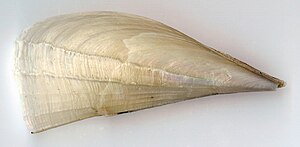Fragile pen shell
| Fragile pen shell | ||||||||||||
|---|---|---|---|---|---|---|---|---|---|---|---|---|

Atrina fragilis |
||||||||||||
| Systematics | ||||||||||||
|
||||||||||||
| Scientific name | ||||||||||||
| Atrina fragilis | ||||||||||||
| ( Pennant , 1777) |
The Atrina fragilis ( Atrina fragilis ) is a shell - type in the family of pen shells (Pinnidae) from the order of Ostreida .
features
The fan-shaped to triangular housing, which is up to 48 cm long, has the same flaps and is trimmed at the rear end. It is very unequal, the small vertebrae are at the very front end. The slightly convex rear edge gapes, but because of the somewhat flexible shell it can be closed by the sphincter muscles. The dorsal margin is long and straight, while the ventral margin is slightly curved sinusoidally. In the front area of the ventral margin (in the sediment) there is also a gaping place for the byssus . The case is quite flat in relation to the width (about three times as wide as it is thick). The inner edge of the case is smooth. In the front part, the tip of the housing can be separated by a few septa. The ligament lies on the outside on a narrow resilifer and extends over two thirds of the length of the dorsal margin. The lock is toothless.
The dorsal part of the housing has eight to twelve low, roughened rib rays, which on adult and larger housings gradually weaken and can disappear completely. The rib rays are often scaly on juvenile enclosures.
The shell is comparatively thin and fragile. still a bit flexible. The mineral shell consists of the inner, aragonitic mother-of-pearl layer and an outer, calcitic prismatic layer. It is translucent, the inside shiny. The periostracum has various shades of brown with a blackish vortex.
The anterior sphincter is small and the posterior sphincter is very large. It is located approximately in the middle near the rear surface line (based on the width).
Geographical distribution, habitat and way of life
The fragile pen shell occurs in the eastern North Atlantic from southern England to North Africa and in the Mediterranean in slightly deeper water to a depth of about 200 meters.
The sex products are released into the open water, where the eggs are fertilized. The development takes place via a planktotrophic Veliger larva, which changes to soil life after five to ten days. The animals can live to be eight to ten years old.
The subspecies Atrina fragilis kalloensis Marquet, 1995 occurs in the Oorderen Sand-Member of the Lillo-Formation (Middle Pliocene ).
Hazard and protection
The fragile pen shell used to be a common species in the waters of southern England. It has been rare there for about 30 years and has therefore been under protection since 1998 (Wildlife and Countryside Act 1981). They may no longer be collected. Even possession and trading of the cases is prohibited.
Taxonomy
The taxon was first described by Thomas Pennant as Pinna fragilis in 1777 . It is now part of the genus Atrina Gray, 1847. In the older literature, the species appears primarily under the name Pinna pectinata or Atrina pectinata . The real Atrina pectinata is a species from the Indo-Pacific.
supporting documents
literature
- Rosina Fechter, Gerhard Falkner: Mollusks. 287 p., Mosaik-Verlag, Munich 1990 (Steinbach's Nature Guide 10), ISBN 3-570-03414-3 (p. 76 as Pinna pectinata )
- Rudolf Kilias: Lexicon marine mussels and snails. 2nd edition, Verlag Eugen Ulmer, Stuttgart 1997 ISBN 3-8001-7332-8 (p. 191)
- Fritz Nordsieck: The European sea shells (Bivalvia). From the Arctic Ocean to Cape Verde, the Mediterranean Sea and the Black Sea. 256 p., Gustav Fischer Verlag, Stuttgart 1969 (p. 41 as Pinna (Atrina) pectinata )
- Guido Poppe and Yoshihiro Goto: European Seashells Volume 2 (Scaphopoda, Bivalvia, Cephalopoda) . 221 p., Verlag Christa Hemmen, Wiesbaden 1993 (2000 unc. Reprint), ISBN 3-925919-10-4 (p. 55)
On-line
- Northern Ireland Priority Species
- Marine Bivalve Shells of the British Isles: Atrina fragilis (Pennant, 1777) (site of the National Museum Wales, Department of Natural Sciences, Cardiff)
Individual evidence
- ^ Robert Marquet: A revision of the Caenozoic Pinnidae from Belgium (Mollusca, Bivalvia). Bulletin de l'Institut Royal des Sciences Naturelles de Belgiques Sciences de la Terre, Bulletin van het Koninklijk Belgisch Instituut voor Natuurwetenschappen, Aardwetenschappen, 65: 241-256, 1995 PDF
- ↑ Protection for wild animals on Schedule 5 of the Wildlife and Countryside Act, 1981 . Website visited: 7th July 2015.
- ^ Thomas Pennant: British Zoology, Vol. 4: Crustacea. Mollusca. Testacea. Class. V. Crustacea. Class VI. Vermes. Worms. VIII + 154 S., XCIII Tafeln, London, White, 1777 Online at GDZ - Göttingen Digitization Center (p. 114)
- ↑ MolluscaBase: Atrina fragilis (Pennant 1777)
